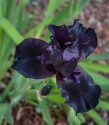The color of midnight is synonymous with the witching hour when the souls of the dead are closest to us and all is dark and spooky. Imagine the silhouette of a bat and of course, the proverbial bad-luck black cat.
But creepy crawlies and sinister potions aside, the color black—or as close as nature gets to it—is actually a fun and surprising color to work into your garden, at All Hallows’ Eve or anytime. From deer-resistant “Coal Seam” black bearded iris (plant the bulbs now!) to the “Sorbet Black Delight” viola, which loves the cooler weather, there are foothill-friendly plants to consider planting now to add a shock of near-black flowers or foliage to your garden. Of the following, most are perennial in our climate zone.
“Black Lace” Elderberry (Sambucas nigra) is a gorgeous, large bush with finely cut leaves reminiscent of Japanese maples. The foliage is purple black, and in spring, it sports soft pink flowers. In autumn the bush is loaded with purple-red berries that birds love, and that you can harvest to make jam or wine. The leaves, stems and unripe berries are toxic though, so situate the bush accordingly.
“Midnight Ruffles” Lenten rose (Hellebore) is perfect for the cool, shady woodland garden. Its near-black blooms with white and yellow centers put on a show from mid-winter through early spring. The plant itself grows to 20” tall and almost as wide. While there won’t be any flowers at Halloween, the plant was used centuries ago in witchcraft and medicinally, so if you’re so inclined . . .
“Obsidian” coral bells (Heuchera) offers maroon-black foliage on another beloved woodland plant. It prefers part to full shade and sends up tall, slim stems topped with small pink or white flowers in spring.
Bugle weed (Ajuga) is a “black” plant that, like vampires, doesn’t do well in full sun. It is a fast-growing, attractive groundcover with coal-dark green leaves. In mid-to late spring it forms dramatic stalks of purple flowers.
Black mondo grass is a dense, purplish black, mounding plant that is great for borders or interspersed among other plants that prefer regular water. It produces dark lavender flowers in summer that are followed by purple berries in the fall.
Especially good in pots are “Black Prince” Coleus and the velvety “Black Cat” petunia (you can buy seeds now online).
Getting back to the scary season at hand, how about this dark-as-night oddball: “Japanese Black Kabocha,” a knobby-skinned, almost-black “pumpkin” with yellow-orange flesh that’s wickedly good. Find one now and you can not only have the coolest Jack-O’-Lantern on the block, but also, seeds to plant next year’s yummy—if not creepy—crop!
Rachel Oppedahl is a University of California Cooperative Extension Master Gardener of Tuolumne County who plans to order a “Black Magic” rose soon. In the meantime, she’s got a string of garlic on the door.
UCCE Master Gardeners of Tuolumne County will answer gardening questions through their hotline at (209) 533-5912. For more information about our public education classes and activities, go to our UCCE Master Gardeners of Tuolumne county website here. They can also be found on Facebook at Master Gardeners-Tuolumne County.





